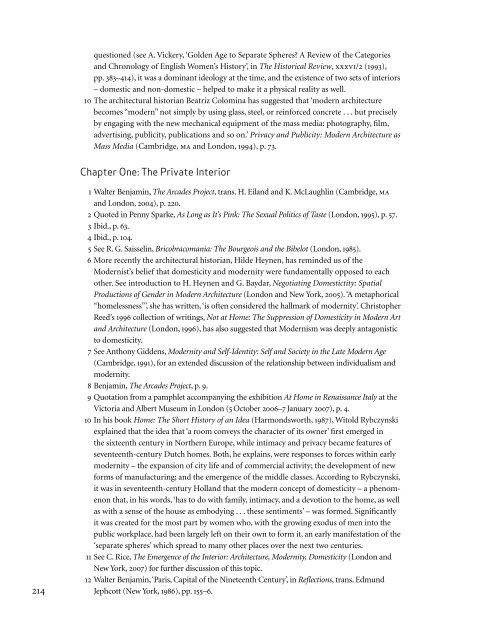Create successful ePaper yourself
Turn your PDF publications into a flip-book with our unique Google optimized e-Paper software.
214<br />
questioned (see A. Vickery, ‘Golden Age to Separate Spheres? A Review of the Categories<br />
and Chronology of English Women’s History’, in <strong>The</strong> Historical Review, xxxvi/2 (1993),<br />
pp. 383–414), it was a dominant ideology at the time, and the existence of two sets of interiors<br />
– domestic and non-domestic – helped to make it a physical reality as well.<br />
10 <strong>The</strong> architectural historian Beatriz Colomina has suggested that ‘modern architecture<br />
becomes “modern” not simply by using glass, steel, or reinforced concrete . . . but precisely<br />
by engaging with the new mechanical equipment of the mass media: photography, film,<br />
advertising, publicity, publications and so on.’ Privacy and Publicity: <strong>Modern</strong> Architecture as<br />
Mass Media (Cambridge, ma and London, 1994), p. 73.<br />
Chapter One: <strong>The</strong> Private <strong>Interior</strong><br />
1 Walter Benjamin, <strong>The</strong> Arcades Project, trans. H. Eiland and K. McLaughlin (Cambridge, ma<br />
and London, 2004), p. 220.<br />
2 Quoted in Penny Sparke, As Long as It’s Pink: <strong>The</strong> Sexual Politics of Taste (London, 1995), p. 57.<br />
3 Ibid., p. 63.<br />
4 Ibid., p. 104.<br />
5 See R. G. Saisselin, Bricobracomania: <strong>The</strong> Bourgeois and the Bibelot (London, 1985).<br />
6 More recently the architectural historian, Hilde Heynen, has reminded us of the<br />
<strong>Modern</strong>ist’s belief that domesticity and modernity were fundamentally opposed to each<br />
other. See introduction to H. Heynen and G. Baydar, Negotiating Domestictity: Spatial<br />
Productions of Gender in <strong>Modern</strong> Architecture (London and New York, 2005). ‘A metaphorical<br />
“homelessness”’, she has written, ‘is often considered the hallmark of modernity’. Christopher<br />
Reed’s 1996 collection of writings, Not at Home: <strong>The</strong> Suppression of Domesticity in <strong>Modern</strong> Art<br />
and Architecture (London, 1996), has also suggested that <strong>Modern</strong>ism was deeply antagonistic<br />
to domesticity.<br />
7 See Anthony Giddens, <strong>Modern</strong>ity and Self-Identity: Self and Society in the Late <strong>Modern</strong> Age<br />
(Cambridge, 1991), for an extended discussion of the relationship between individualism and<br />
modernity.<br />
8 Benjamin, <strong>The</strong> Arcades Project, p. 9.<br />
9 Quotation from a pamphlet accompanying the exhibition At Home in Renaissance Italy at the<br />
Victoria and Albert Museum in London (5 October 2006–7 January 2007), p. 4.<br />
10 In his book Home: <strong>The</strong> Short History of an Idea (Harmondsworth, 1987), Witold Rybczynski<br />
explained that the idea that ‘a room conveys the character of its owner’ first emerged in<br />
the sixteenth century in Northern Europe, while intimacy and privacy became features of<br />
seventeenth-century Dutch homes. Both, he explains, were responses to forces within early<br />
modernity – the expansion of city life and of commercial activity; the development of new<br />
forms of manufacturing; and the emergence of the middle classes. According to Rybczynski,<br />
it was in seventeenth-century Holland that the modern concept of domesticity – a phenomenon<br />
that, in his words, ‘has to do with family, intimacy, and a devotion to the home, as well<br />
as with a sense of the house as embodying . . . these sentiments’ – was formed. Significantly<br />
it was created for the most part by women who, with the growing exodus of men into the<br />
public workplace, had been largely left on their own to form it, an early manifestation of the<br />
‘separate spheres’ which spread to many other places over the next two centuries.<br />
11 See C. Rice, <strong>The</strong> Emergence of the <strong>Interior</strong>: Architecture, <strong>Modern</strong>ity, Domesticity (London and<br />
New York, 2007) for further discussion of this topic.<br />
12 Walter Benjamin, ‘Paris, Capital of the Nineteenth Century’, in Reflections, trans. Edmund<br />
Jephcott (New York, 1986), pp. 155–6.



